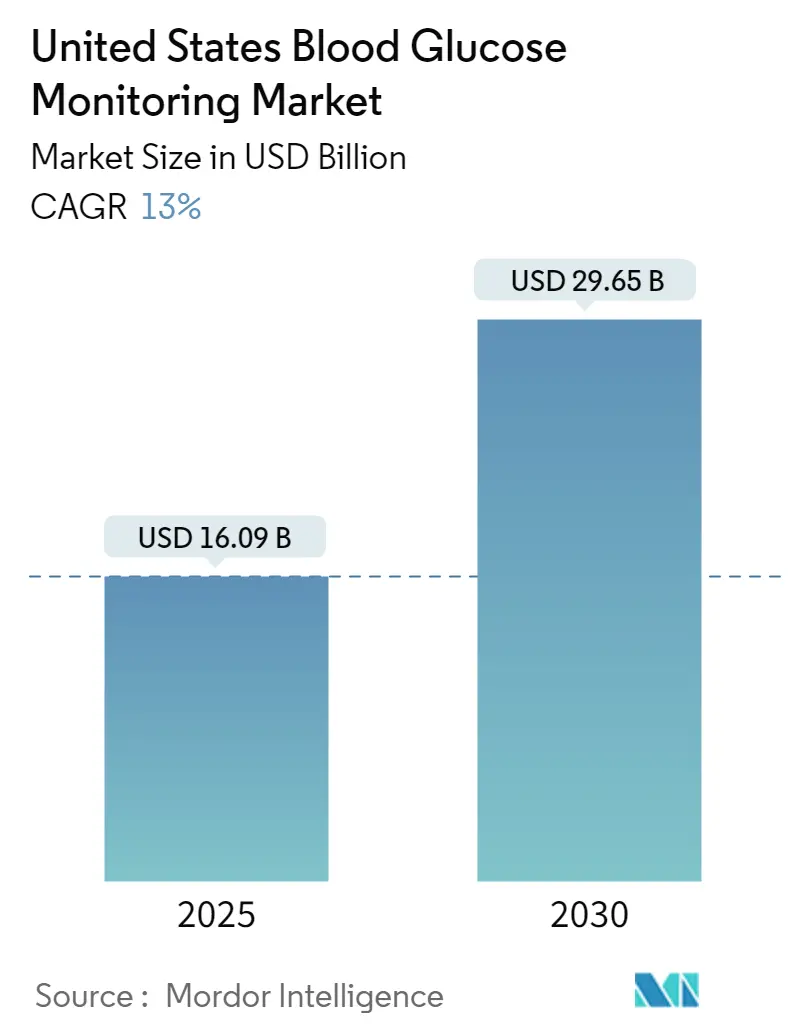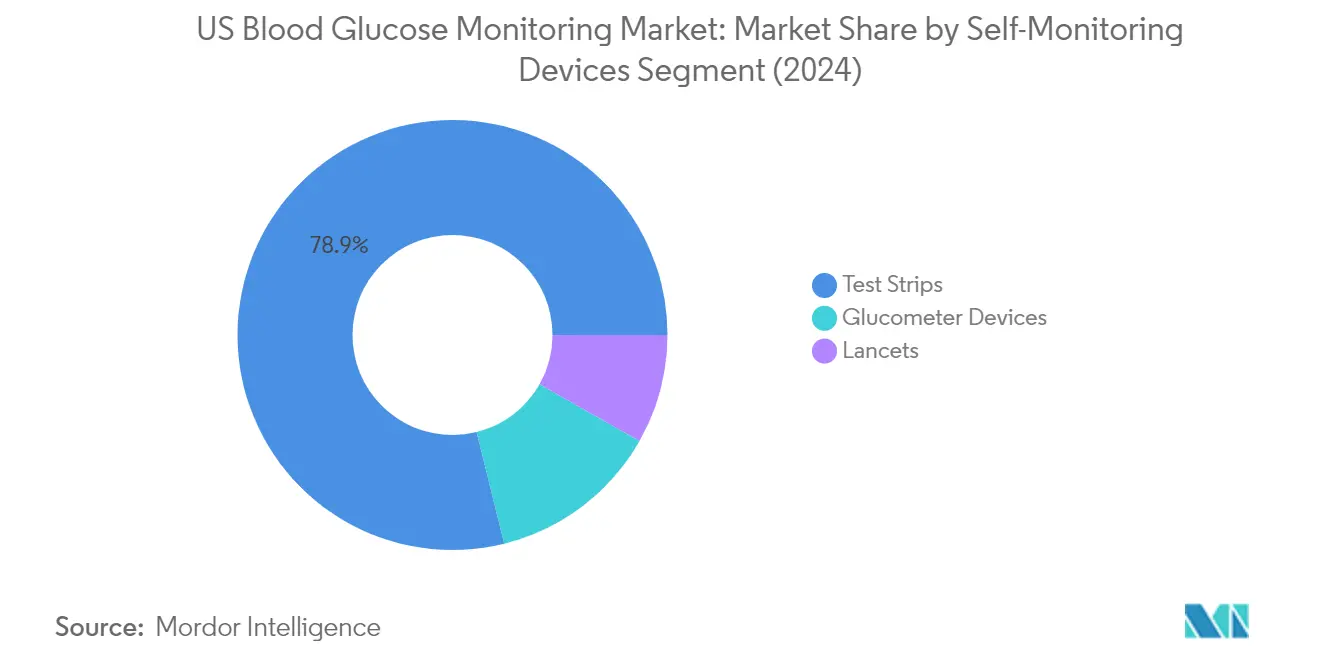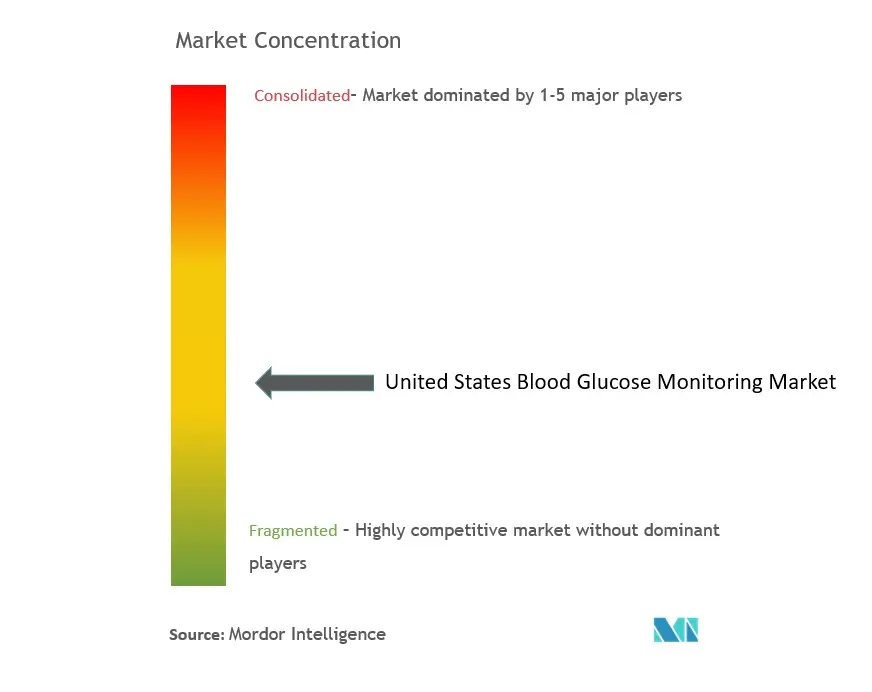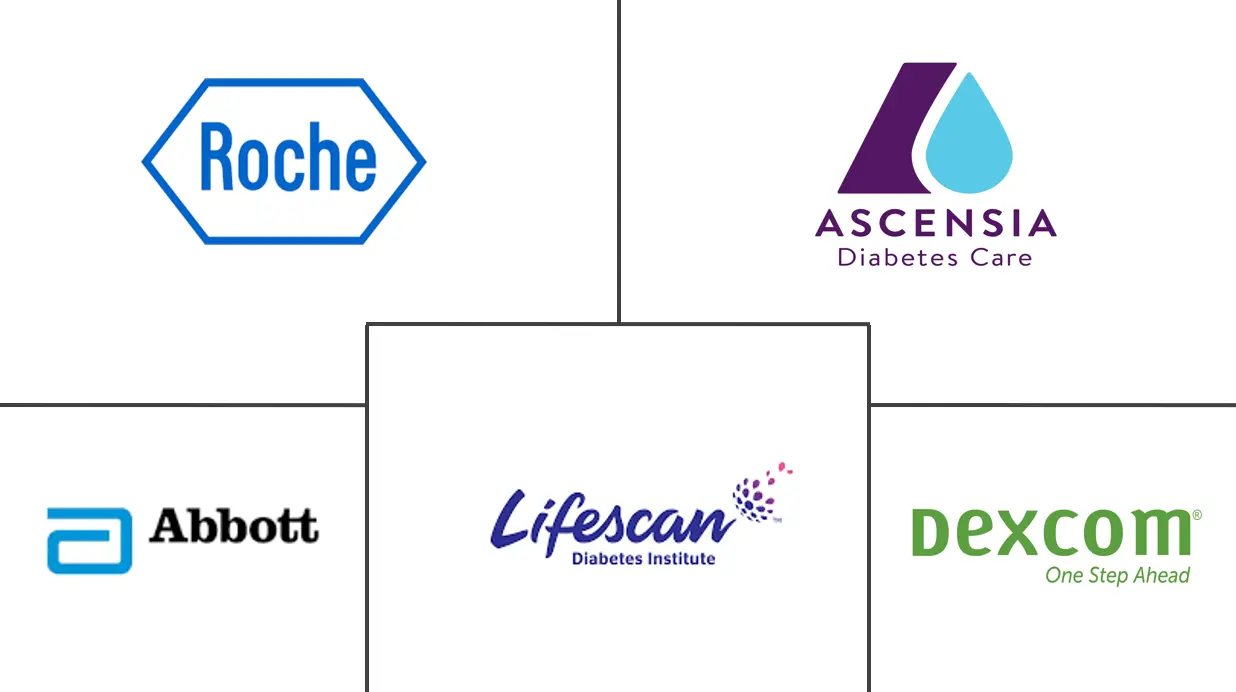
United States Blood Glucose Monitoring Market Analysis by Mordor Intelligence
The United States Blood Glucose Monitoring Market size is estimated at USD 16.09 billion in 2025, and is expected to reach USD 29.65 billion by 2030, at a CAGR of 13% during the forecast period (2025-2030).
The blood glucose monitoring industry is experiencing significant transformation driven by technological innovation and changing healthcare dynamics. Technological advancements in blood glucose meters now include cellular-connected devices that automatically upload SMBG data to secure cloud-based databases, enabling improved sharing and monitoring capabilities. These innovations facilitate real-time glucose monitoring and timely support for patients with abnormal blood glucose readings. The integration of artificial intelligence and machine learning algorithms has enhanced the accuracy and predictive capabilities of monitoring devices. This technological evolution is particularly crucial given that approximately 32.8% of adults aged 18 and over in the United States were obese in 2021, a condition closely linked to diabetes care needs.
Insurance coverage and accessibility have undergone substantial improvements, marking a significant shift in the market landscape. In October 2022, the Centers for Medicare and Medicaid Services (CMS) published a modified Local Coverage Determination (LCD) for continuous glucose monitoring (CGM), expanding coverage to include people with diabetes who receive insulin treatment or have a history of problematic hypoglycemia. This policy change has made advanced monitoring technologies more accessible to a broader patient population. Healthcare providers and insurance companies are increasingly recognizing the long-term cost benefits of preventive monitoring, leading to more comprehensive coverage options for patients.
The market is witnessing a surge in non-invasive monitoring technologies, representing a paradigm shift in diabetes monitoring. Several innovative companies are developing breakthrough solutions, including wristband-based monitoring systems using miniaturized MRI-like technology, radio wave-based measurement devices, and nickel-sized, needle-free CGM systems. These developments are complemented by the emergence of new players focusing on detecting glucose levels through alternative methods such as sweat and tears, utilizing combinations of ultrasonic, electromagnetic, and thermal technologies. The industry saw significant progress in 2022 with Abbott receiving FDA clearance for its next-generation FreeStyle Libre 3 system in May, followed by Dexcom's G7 continuous glucose monitoring device approval in December.
Digital health integration has become a cornerstone of modern smart glucose monitoring solutions, transforming traditional monitoring approaches into comprehensive health management systems. Companies are increasingly focusing on developing smart glucometer devices that seamlessly connect to mobile devices, enabling real-time data sharing with healthcare providers and caregivers. These platforms incorporate advanced analytics capabilities, providing actionable insights and personalized recommendations for better diabetes management. The integration extends beyond basic monitoring to include automated insulin delivery systems, dietary tracking, and lifestyle management tools, creating a more holistic approach to diabetes management systems. This digital transformation has particularly benefited from the development of new mobile applications and cloud-based platforms that facilitate remote monitoring and telehealth services.
United States Blood Glucose Monitoring Market Trends and Insights
Rising Prevalence of Diabetes and Associated Complications
The United States is experiencing an unprecedented rise in diabetes cases, with the CDC National Diabetes Statistics Report 2022 revealing that more than 130 million adults are living with diabetes or prediabetes. This surge is particularly concerning as the proportion of adults with diabetes has more than doubled in the past 20 years, driven by increasing obesity rates, sedentary lifestyles, and unhealthy dietary habits. The disease burden is disproportionately affecting communities of color, rural populations, and individuals with lower education and income levels, highlighting the critical need for accessible blood glucose monitoring solutions.
The American Diabetes Association, along with other prominent medical organizations, including the Endocrine Society, American College of Physicians, and American Academy of Pediatrics, have issued urgent calls to action addressing social determinants of health at individual, organizational, and policy levels. In 2021, the ADA published a comprehensive scientific review examining the relationships between social determinants of health and diabetes risk outcomes, particularly focusing on socioeconomic status, health literacy, food environment, and physical environments, emphasizing the growing need for effective diabetic monitoring device solutions across all demographic groups.
Technological Advancements in Blood Glucose Monitoring Devices
The blood glucose monitoring market is being revolutionized by significant technological innovations, particularly in non-invasive monitoring solutions. Several companies are developing groundbreaking technologies, such as Alertgy's miniaturized MRI-like technology in a wristband format, Know Labs' radio wave-based glucose measurement system, and Life Plus's LifeLeaf wearable device that combines multiple sensor technologies. These innovations are transforming the traditional approach to glucose monitoring, making it more convenient and user-friendly for patients while maintaining accuracy and reliability.
Recent product launches demonstrate the industry's commitment to technological advancement. Abbott's FreeStyle Libre 3, approved by the FDA in May 2022, represents a significant breakthrough as the world's smallest and thinnest continuous glucose monitoring (CGM) sensor. Similarly, Roche's cobas pulse system, launched in January 2022, introduces the first professional blood glucose meter with an Android-based operating system, incorporating industry-leading medical apps for healthcare professionals. Additionally, startup companies like AnnNIGM, Novio Sense, Easy Glucose, and GraphWear Technologies are developing innovative CGM devices that can detect glucose levels through sweat and tears using a combination of ultrasonic, electromagnetic, and thermal technologies, signaling a new era in glucose monitoring technology.
Favorable Healthcare Policies and Insurance Coverage
The expansion of healthcare coverage for blood glucose monitoring devices has been significantly enhanced by recent policy changes. In October 2022, the Centers for Medicare and Medicaid Services (CMS) published a modified Local Coverage Determination (LCD) for continuous glucose monitoring, extending coverage to individuals with diabetes who receive insulin treatment or have a history of problematic hypoglycemia. This policy change represents a crucial step in making advanced monitoring technologies more accessible to a broader patient population, particularly benefiting those who previously faced financial barriers to accessing these essential devices.
The American Diabetes Association, National Academy of Medicine, NIH, CDC, and CMS are actively promoting an integrated model of care through various initiatives focused on education, awareness building, and patient support for monitoring device usage. Insurance companies are increasingly covering approximately 80% of the total expenditure on healthcare devices, including blood glucose meters and testing supplies. Medicare Part B now includes coverage for blood glucose meters and necessary test strips as durable medical equipment, making these essential monitoring tools more affordable for beneficiaries and encouraging wider adoption among diabetic patients.
Segment Analysis: Self-Monitoring Blood Glucose Devices
Test Strips Segment in US Blood Glucose Monitoring Market
Test strips dominate the self-monitoring blood glucose devices market, commanding approximately 79% market share in 2024, positioning it as the cornerstone segment of the industry. The segment's dominance is primarily attributed to the continuous nature of glucose test strip consumption, as they are single-use items that require regular replacement, unlike blood glucose meter devices which are one-time purchases. The widespread availability of glucose test strip through various distribution channels, including big box stores, independent retail pharmacies, and online platforms like Amazon and GoodRx, has significantly contributed to their market leadership. Additionally, the comprehensive insurance coverage for test strips in the United States, with most health insurance plans covering approximately 80% of the total expenditure, has further solidified their market position. The segment's strength is also reinforced by technological advancements in test strip design, with newer variants requiring smaller blood samples and offering faster analysis times.

Glucometer Devices Segment in US Blood Glucose Monitoring Market
The glucometer devices segment is experiencing the most rapid growth in the self-monitoring blood glucose devices market, with an expected growth rate of approximately 10% during 2024-2029. This accelerated growth is driven by significant technological advancements, particularly in smart blood glucose meter devices that can now seamlessly connect to mobile devices, enabling real-time monitoring and data sharing with healthcare providers. The segment's expansion is further supported by the development of innovative features such as smartphone integration capabilities and enhanced battery efficiency. The increasing adoption of personal-use glucometers, coupled with reduced costs and rising awareness among diabetes patients, is propelling this segment's growth. Additionally, the emergence of glucometers that can be directly plugged into smartphones using headphone jacks for automatic value recording is creating new growth opportunities in this segment.
Remaining Segments in Self-Monitoring Blood Glucose Devices
The lancets segment, while smaller in market share, plays a crucial role in the self-monitoring blood glucose devices ecosystem. Lancets are essential components used for capillary blood sampling and are designed with safety features to prevent accidental sticking and reduce infection risks. The segment's development is characterized by ongoing innovations in lancet design, focusing on minimizing patient discomfort during blood sampling. The introduction of new varieties of lancet devices that cause less pain to users has been instrumental in maintaining steady market growth. The segment also benefits from the increasing awareness about the importance of using fresh, sterile lancets for each testing procedure to ensure accurate results and maintain proper hygiene standards.
Segment Analysis: Continuous Blood Glucose Monitoring Devices
Sensors Segment in Continuous Blood Glucose Monitoring Devices Market
The sensors segment dominates the United States Continuous Blood Glucose Monitoring Devices market, commanding approximately 80% of the total market share in 2024. This significant market position is attributed to the increasing adoption of CGM systems that provide users with the convenience of checking glucose levels throughout the day without multiple fingerstick testing. The segment's growth is further bolstered by technological advancements such as improved glucose sensor accuracy, longer sensor life, and enhanced integration capabilities with smartphones and other digital health platforms. The sensors' ability to provide real-time glucose readings and predictive alerts for potential high or low glucose events has made them an essential component in modern diabetes monitoring, particularly for patients requiring intensive insulin therapy.
Durables Segment in Continuous Blood Glucose Monitoring Devices Market
The durables segment, which includes receivers and transmitters, is experiencing the fastest growth in the continuous glucose monitoring devices market, with a projected growth rate of approximately 20% during 2024-2029. This accelerated growth is driven by the increasing integration of advanced features such as improved battery life, enhanced connectivity options, and more user-friendly interfaces. The segment's expansion is further supported by the growing preference for CGM systems that offer seamless data transmission to multiple devices and healthcare providers. The durables segment is also benefiting from technological innovations that focus on making devices more comfortable to wear, more discrete, and increasingly compatible with various digital health platforms and automated insulin delivery systems.
Competitive Landscape
Top Companies in United States Blood Glucose Monitoring Market
The United States blood glucose monitoring market is led by prominent players including Abbott, Dexcom, Medtronic, Roche, and LifeScan. These companies are heavily investing in product innovation, particularly in developing advanced continuous glucose monitoring systems and integrated diabetes management system platforms. The competitive landscape is characterized by strategic partnerships with healthcare providers, technology companies, and insurance providers to enhance product accessibility and market penetration. Companies are focusing on expanding their distribution networks through both traditional medical channels and direct-to-consumer approaches. There is also a notable trend toward developing cloud-based data management solutions and mobile applications that enable real-time monitoring and data-sharing capabilities. Market leaders are increasingly emphasizing user experience and convenience through features like extended sensor wear time, improved accuracy, and seamless integration with insulin delivery systems.
Consolidated Market with Strong Technology Focus
The blood glucose monitoring market in the United States demonstrates a high level of consolidation, dominated by large multinational medical device companies with extensive research and development capabilities. These established players leverage their strong financial positions and extensive distribution networks to maintain market leadership, while smaller companies typically focus on niche segments or innovative technologies. The market structure favors companies with comprehensive diabetes care portfolios that can offer integrated solutions combining monitoring devices, data management platforms, and support services.
The competitive dynamics are shaped by a combination of organic growth strategies and strategic acquisitions, with larger players regularly acquiring innovative startups to expand their technological capabilities and market presence. Market participants are increasingly focusing on building comprehensive diabetes management ecosystems rather than standalone monitoring devices. The barrier to entry remains high due to stringent regulatory requirements, substantial investment needs for research and development, and the importance of established relationships with healthcare providers and insurance companies.
Innovation and Integration Drive Market Success
Success in the glucose monitoring market increasingly depends on companies' ability to develop innovative technologies while maintaining strong relationships with healthcare providers and payers. Incumbent companies must focus on continuous product improvement, enhanced connectivity features, and expanded reimbursement coverage to maintain their market positions. The ability to provide comprehensive diabetes management solutions, including data analytics and personalized patient support, has become crucial for maintaining competitive advantage. Companies must also navigate the evolving regulatory landscape while ensuring their products remain cost-effective for both healthcare systems and end-users.
For new entrants and smaller players, success lies in identifying underserved market segments and developing specialized solutions that address specific user needs. Companies must focus on building strategic partnerships with established players, healthcare providers, and technology companies to overcome market entry barriers. The increasing emphasis on value-based healthcare and patient outcomes presents opportunities for companies that can demonstrate superior clinical benefits and cost-effectiveness. Future success will largely depend on the ability to balance innovation with affordability while meeting stringent regulatory requirements and maintaining strong relationships with key stakeholders in the healthcare ecosystem.
United States Blood Glucose Monitoring Industry Leaders
-
Abbott Diabetes Care
-
Dexcom Inc.
-
Lifescan
-
Roche Holding AG
-
Ascensia Diabetes Care
- *Disclaimer: Major Players sorted in no particular order

Recent Industry Developments
December 20, 2022: Dexcom announced FDA approval for their next-generation product, the Dexcom G7 CGM. The G7 is approved for people with all types of diabetes, ages two and older.
October, 2022: Abbott announced that the Freestyle Libre 3 is now available in pharmacies nationwide after it received FDA clearance in May 2022.
United States Blood Glucose Monitoring Market Report Scope
Blood glucose monitoring tests the concentration of glucose in the blood (glycemia). Particularly important in diabetes management, a blood glucose test is typically performed to determine the fluctuation in blood glucose level and to take or alter the medication accordingly, especially for insulin users. Achieving optimum glycemic results can be very difficult without frequent monitoring of blood glucose levels. The United States blood glucose monitoring market is segmented by type (self-monitoring blood glucose devices and continuous blood glucose monitoring devices) and components (glucometer devices, test strips, lancets, sensors, and durables). The report offers the value (in USD million) and volume (in unit million) for the above segments.
| Glucometer Devices |
| Test Strips |
| Lancets |
| Sensors |
| Durables (Receivers and Transmitters) |
| Self-monitoring blood glucose devices (Value and Volume, 2017 - 2028) | Glucometer Devices |
| Test Strips | |
| Lancets | |
| Continuous blood glucose monitoring devices (Value and Volume, 2017 - 2028) | Sensors |
| Durables (Receivers and Transmitters) |
Key Questions Answered in the Report
How big is the United States Blood Glucose Monitoring Market?
The United States Blood Glucose Monitoring Market size is expected to reach USD 16.09 billion in 2025 and grow at a CAGR of 13% to reach USD 29.65 billion by 2030.
What is the current United States Blood Glucose Monitoring Market size?
In 2025, the United States Blood Glucose Monitoring Market size is expected to reach USD 16.09 billion.
Who are the key players in United States Blood Glucose Monitoring Market?
Abbott Diabetes Care, Dexcom Inc., Lifescan, Roche Holding AG and Ascensia Diabetes Care are the major companies operating in the United States Blood Glucose Monitoring Market.
What years does this United States Blood Glucose Monitoring Market cover, and what was the market size in 2024?
In 2024, the United States Blood Glucose Monitoring Market size was estimated at USD 14.00 billion. The report covers the United States Blood Glucose Monitoring Market historical market size for years: 2019, 2020, 2021, 2022, 2023 and 2024. The report also forecasts the United States Blood Glucose Monitoring Market size for years: 2025, 2026, 2027, 2028, 2029 and 2030.
Page last updated on:



